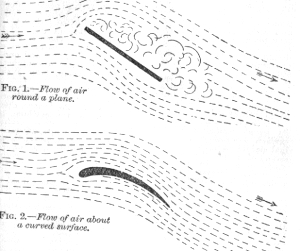Aeroplanes - Early history of Flying. Page 1
Flying machines are distinguished from balloons and dirigibles in being 'heavier than air', and consequently raised and supported by dynamic means alone, by the reaction of the air on surfaces driven through it. Although the first practicable flying-machine was built and flown so long agoas 1809 by Sir George Cayley, in England, no definite results were achieved until the last decade of the 19th century.
Progress was so long delayed by two causes: firstly, the lack of information relating to the laws of air resistance; and secondly, the want of suitable motive power of sufficient lightness. The lightest motor known to Sir George Cayley - Boulton and Watt's steam engine - weighed but little under 200 lbs. per H.P. It was not until the development of the internal combustion engine, which in its latest form, weighs as little as 3 lbs. per H.P., that power-driven flight became possible.
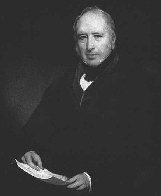
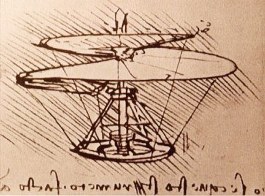
The difficulty of discovering accurate information regarding the laws of air resistance to bodies moving through it, which constitutes the science known as aerodynamics, proved an equally effectual bar to the development of the flying- machine until later years. This difficulty is due mainly to the practical invisibility and tenuity of the air, and to the fact that in motion it is a most irregular and turbulent fluid.
The methods of research in aerodynamics, brought to a state of perfection by professor Langley in America, by professor Dines and Sir Hiram Maxim in England, and by M. Eiffel in France, are twofold: firstly, by mounting the bodies to be tested on the long arm of a whirl-table rotating at high speed; or, secondly, by placing them in an artificially produced current of air. By varying the shape and position of the body, it has been possible, by employing delicate recording instruments, to obtain fairly accurate information on the most important laws of aerodynamics.
Among the most important phenomena of the air that bear directly on the problems connected with flying machines were the following: Save at very high altitudes but particularly in the vicinity of the earth's surface, the wind - which is simply air in motion - has the most extraordinary variations in speed, fluctuating constantly, and almost instantaneously, from nearly dead calm to a very high velocity.
Langley's experiments showed, to take one example, that a wind blowing at an average velocity of 25 miles an hour fluctuated, within the course of a single minute, from 36 to 0 miles an hour. Similar instantaneous variations occur in the direction, both horizontal and vertical, of the wind, amounting to as much as 20°. It has not yet been determined whether these variations form a portion of a uniform wave-movement or pulsation in the atmosphere, or whether they offer any explanation of some of the more mysterious phenomena of bird-flight, such as the soaring of the condor.
Further, the atmosphere diminishes in density in proportion to the altitude; and the average velocity of the wind increases constantly with the height. Both these phenomena will probably render navigation impossible at heights exceeding 15 000 ft. Although the same broad principle - viz., the reaction of the air on surfaces driven through it - applies in general to dynamic flying-machines, these can nevertheless be divided into three classes according to the means whereby this principle is applied. 1) The helicopter, sustained by the rotation of horizontal propellers. 2) The ornithopter sustained by flapping wings as in the most common form of bird-flight. 3) The aeroplane sustained by the reaction of the air on passive surfaces driven through the air.
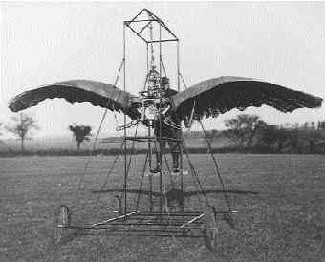
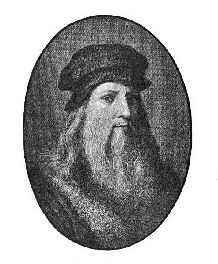
The helicopter was the first type of flying-machine to be designed on scientific lines - by Leonardo da Vinci, about the year 1500. In spite of continues attempts since made to build a practical machine of this class, only two instances can hitherto be recorded of a helicopter raising a man from the ground. But as, in both cases, the height attained above the ground amounted only to a few inches, the helicopter cannot be said to have met with any success yet.
The machines referred to were both built in France: by Cornu at Lisieux in 1908, and by Brequet-Richet at Donai in the same year. Machines of this type are raised by the rotation of one or more horizontal propellers; forward movement is effected either by inclining the axis of these propellers or by an ordinary vertical propeller. Mechanically, the helicopter is less efficient than the aeroplane, and seems to offer little or no prospect of success, although it may possible prove useful as an adjunct to the aeroplane proper.
The ornithopter, or machine driven by the action of wings reciprocated like those of a bird or an insect, has met with even less success hitherto, no single machine of this type having even flown - with the exception of a few diminutive models (those of Penaud in France, Kress in Germany and Hargrave in Australia) - although many have been designed from the time of Leonardi da Vinci onwards.
In this case, the difficulty seems to be chiefly one of the transmission of power, the mechanism necessarily being extremely complicated. From a theoretical point of view, the ornithopter, however, is con- siderably more efficient than the aeroplane; and, having lately aroused much attention seems to offer a fair chance of success in the future, either in itself or used as propelling mechanism.
The third type, the aeroplane, has been developed with such extraodinary rapidity as to have become, within the years since its practical inauguration in 1906, not merely the single typeof a successful flying-machine, but almost a recog- nized method of locomotion and transport. It was with an aeroplane that the first flight in history was made by the French engineer, Ader, in 1891.
Again at Satory in France, Ader made a second flight in private on a steam driven aeroplane (now preserved at the Conservatoire des Arts et Metiers in Paris) on October 17, 1897. On December 17, 1903, the brothers Wright, in America, made their first power-flight; while the very first public flight was made in France by Santos Dumont on September 14, 1906.


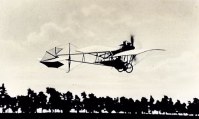
Before it was possible to produce a power-driven aeroplane, experiments over a long course of years were made with aer- oplanes not provided with propelling apparatus, and known as gliders. The first glider was built in 1809 by Sir George Cayley, and successfully flown, though not with a man on board; but the experiments in the gliders made by the German engineer Otto Lilienthal from 1889 onwards, may be said to form the actual inception of the present-day aeroplane.
Until his death in 1897, Lilienthal made over 2000 glides and brought about many improvements in design. His work was continued in Eng- land by P.S.Pilcher and in the United States by O. Chanute Herring and the Wright brothers.
Glider aircraft are heavier-than-air craft that are supported in flight by the dynamic reaction of the air against their lifting surfaces, and whose free flight does not depend on an engine. Mostly these types of aircraft are intended for routine operation without engines, though engine failure can force other types of aircraft to glide.
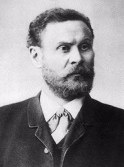
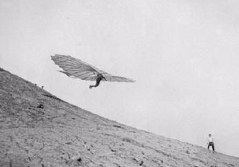
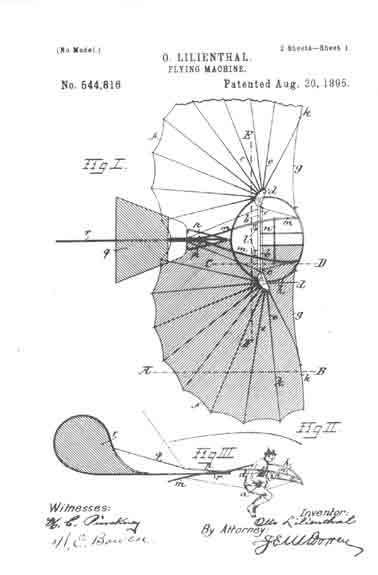

Essentially, the aeroplane may be compared to a kite in which the pull of the string is replaced by the thrust of the pro- peller. In its earliest form the aeroplane consisted of a flat surface moved through the air in a position slightly inclined from the horizontal; in its forward movement the plane experiences resistance from the air.
As this resistance is directed partly on the under side, it will be partly converted into a lifting force. Of these two forces - head resistance or drift, and the lifting or sustaining force or lift - the first, being unproductive, must be reduced as far as possible; the second, lift, must, on the other hand be raised to the highest possible degree.
This end is achieved by employing, instead of flat surfaces or planes, surfaces curved in the direction of flight. Curfed sur- faces were first used by Cayley in 1809, but were scientifically utilized for the first time by Lilienthal from 1889 onwards. The curved surface has less head resistance than a plane, and gives more lift. The reason for this is apparent from Fig.1 and 2, which are drawn from photographs of the action of the air on (1) a plane, and (2) a curved surface.
In the first case whirls and eddies are produced in the rear of the surface, the discontinuity extending far to the rear; in (2) the streamlines of the air hug both surfaces of the curve very closely, and flow away evenly. In each case a cushion of inert air is formed at the point of impact, which prevents the air current from impinging directly on the leading edge.
